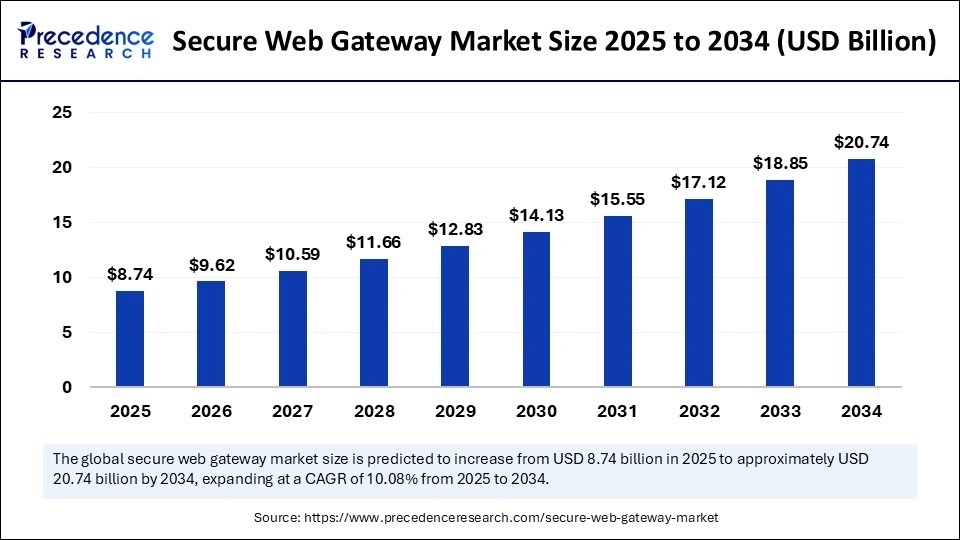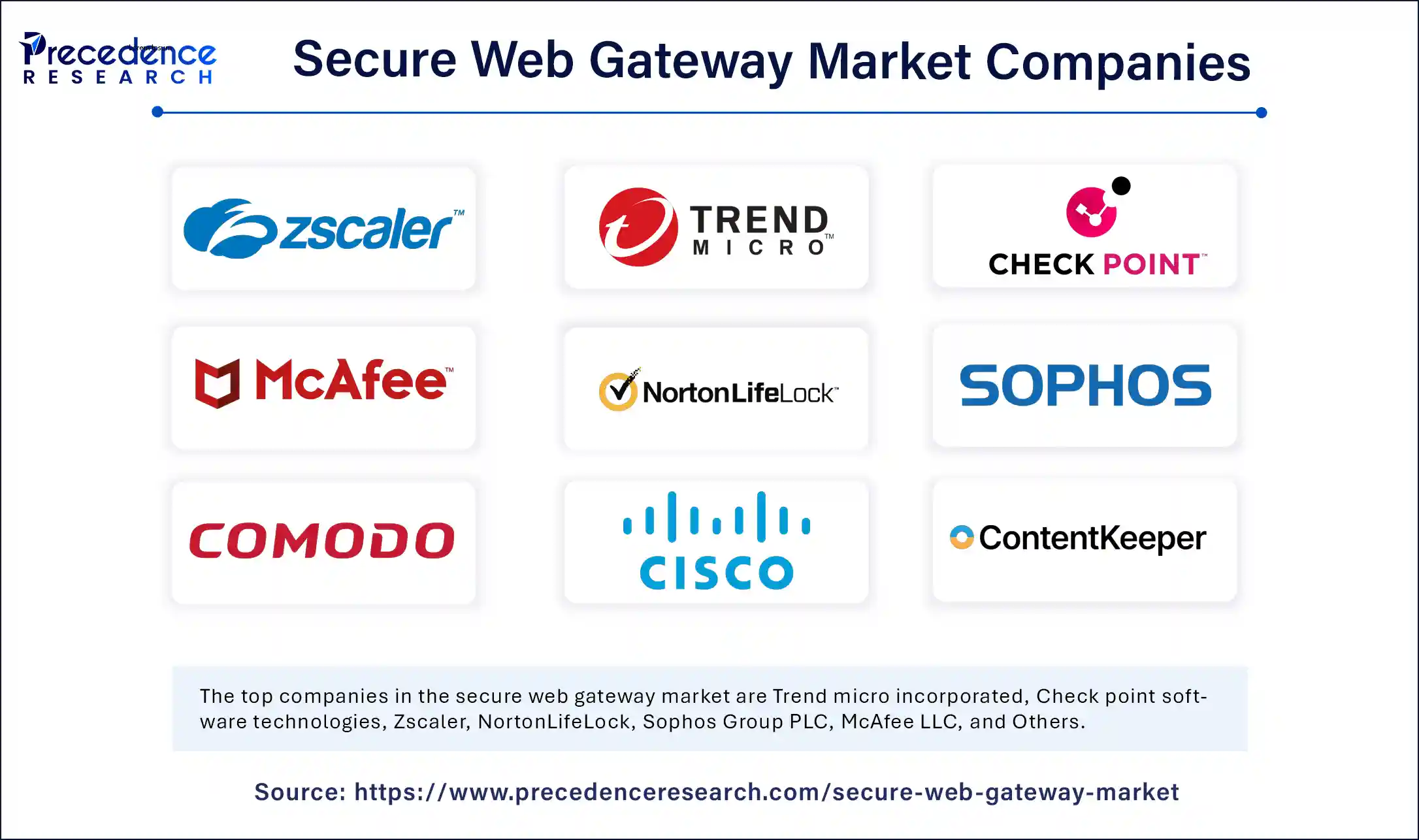
Secure Web Gateway Market Key Points
-
North America accounted for the largest revenue share of 38% in 2024.
-
The Asia Pacific region is anticipated to grow at the fastest CAGR during the forecast period.
-
By organization size, large enterprises contributed the highest revenue share in 2024.
-
The SMEs segment is expected to expand at the fastest CAGR from 2025 to 2034.
-
In terms of deployment, the cloud segment led the market with the major revenue share in 2024.
-
The on-premises segment is projected to grow at the highest CAGR during the forecast period.
-
By component, the solutions segment held the dominant market share in 2024.
-
The services segment is expected to register the fastest growth rate between 2025 and 2034.
-
Among industry verticals, the BFSI segment captured the largest market share in 2024.
-
The IT & telecom segment is projected to witness the fastest CAGR from 2025 to 2034.
Overview of Secure Web Gateway (SWG)
A Secure Web Gateway (SWG) is a cybersecurity solution that protects users from web-based threats by filtering and monitoring internet traffic in real time. It enforces company security policies and prevents access to malicious websites, viruses, spyware, and unauthorized data transfers. SWGs typically include features such as URL filtering, malware detection, application control, HTTPS inspection, data loss prevention (DLP), and cloud access security broker (CASB) integration. These gateways can be deployed on-premises, in the cloud, or in hybrid formats to secure both remote and in-office users.
Importance and Market Relevance
With the increasing shift toward cloud-based applications and remote work, SWGs are critical in providing secure internet access beyond traditional network perimeters. They ensure safe usage of platforms like Microsoft 365, Google Workspace, and social media tools, while protecting sensitive data and maintaining compliance with data protection regulations. The market for SWG is growing rapidly due to rising cyber threats, adoption of zero-trust architectures, and the need for secure digital transformation. As organizations modernize their IT infrastructure, SWGs serve as a vital component of modern, cloud-first security strategies.
How Is AI Strengthening Secure Web Gateway (SWG) Solutions?
AI is central to advancing Secure Web Gateway (SWG) solutions by significantly improving threat detection and response capabilities. Through machine learning and behavioral analytics, AI enables SWGs to analyze web traffic in real time, distinguishing between normal and suspicious activities with greater accuracy. This includes identifying zero-day threats and advanced cyberattacks using anomaly detection techniques. AI also enhances visibility into encrypted traffic and automates policy enforcement, allowing organizations to maintain a strong security posture while efficiently meeting compliance standards.
In addition, AI is accelerating the adoption of cloud-native and Secure Access Service Edge (SASE) architectures within the SWG market. By embedding AI-driven threat intelligence and real-time analytics into cloud-based platforms, SWG providers can offer faster detection, dynamic scalability, and centralized security management. This is especially crucial for supporting remote and hybrid workforces and managing multi-cloud environments. As web-based threats grow more sophisticated, AI-enabled SWGs provide smarter, more adaptive, and proactive protection.
Secure Web Gateway (SWG) Market Growth Factors
-
Increasing Cyber Threats & Regulatory Pressure: The rise in malware, ransomware, and phishing attacks is pushing organizations to adopt SWG solutions for data protection and compliance with regulations like GDPR and CCPA.
-
Rise of Cloud Adoption & Remote Work: As businesses increasingly use cloud services and support remote workforces, SWGs provide centralized and scalable security to protect distributed users and cloud-based applications.
-
Integration of AI/ML for Threat Detection: The use of artificial intelligence and machine learning in SWGs enhances real-time threat detection and reduces false positives, improving overall cybersecurity performance.
-
Alignment with Zero Trust and SASE Models: SWGs are vital components of Zero Trust and Secure Access Service Edge (SASE) frameworks, supporting secure access, continuous authentication, and web traffic inspection at the network edge.
-
Managed Services & SME Adoption: Cloud-based and managed SWG services are making advanced web security more accessible to small and medium-sized enterprises by reducing complexity and lowering costs.
-
Demand from High-Security Verticals: Highly regulated sectors like banking, healthcare, government, and telecom are rapidly adopting SWG solutions to safeguard critical data amid digital transformation.
Market Scope
| Report Coverage | Details |
| Market Size by 2034 | USD 20.74 Billion |
| Market Size in 2025 | USD 8.74 Billion |
| Market Size in 2024 | USD 7.94 Billion |
| Market Growth Rate from 2025 to 2034 | CAGR of 10.08% |
| Dominating Region | North America |
| Fastest Growing Region | Asia Pacific |
| Base Year | 2024 |
| Forecast Period | 2025 to 2034 |
| Segments Covered | Organization Size, Deployment Mode, Component, Industry Vertical, and Region |
| Regions Covered | North America, Europe, Asia-Pacific, Latin America, and Middle East & Africa |
Market Dynamics
Market Drivers
The Secure Web Gateway (SWG) market is experiencing robust growth, driven primarily by the escalating need for advanced cybersecurity solutions amid increasing cyber threats and data breaches. With the rapid adoption of cloud services, bring-your-own-device (BYOD) policies, and remote working models, enterprises are seeking secure methods to monitor and control web traffic to protect sensitive information.
Secure web gateways serve as a vital line of defense by filtering unwanted software, enforcing company policies, and preventing unauthorized data transfers. The rise in phishing attacks, malware, ransomware, and advanced persistent threats (APTs) has compelled organizations to invest in comprehensive web security infrastructures. Additionally, growing regulatory pressures, such as compliance with GDPR, HIPAA, and India’s DPDP Act, are driving demand for SWG solutions that ensure data integrity and secure access to cloud-based applications.
Opportunities
Significant opportunities exist in the integration of SWG with other cybersecurity technologies, such as Secure Access Service Edge (SASE) and Zero Trust Network Architecture (ZTNA), offering a unified approach to web and network security. As businesses increasingly migrate to cloud environments, SWGs can evolve into cloud-native security solutions capable of delivering real-time threat protection, data loss prevention, and user behavior analytics. Furthermore, sectors like healthcare, BFSI, education, and government are showing a heightened demand for SWG solutions due to the critical nature of their data and operations.
Emerging markets in Asia-Pacific, Latin America, and the Middle East also offer substantial growth potential, as enterprises in these regions look to bolster their cybersecurity posture. The rising awareness about the need for proactive rather than reactive security models creates a fertile ground for vendors offering intelligent, AI-driven SWG solutions tailored to industry-specific requirements.
Challenges
Despite the growing importance of SWGs, the market faces several challenges that could hinder widespread adoption. Integration complexities with existing security infrastructure and legacy systems often make deployment cumbersome and costly. Moreover, the high cost of implementation and subscription-based pricing models may deter small and medium-sized enterprises (SMEs) from adopting advanced SWG solutions. Another critical issue is the rapid evolution of cyber threats, which demands continuous updates and adaptability of SWG technologies to remain effective.
Additionally, latency concerns in web access due to traffic filtering and inspection can impact user experience, particularly in high-speed business environments. Inadequate cybersecurity expertise and a shortage of skilled professionals to manage and optimize these solutions also present notable constraints, especially in developing economies.
Regional Outlook
North America currently dominates the secure web gateway market, fueled by a mature cybersecurity ecosystem, strong regulatory frameworks, and widespread adoption of digital technologies across industries. The United States, in particular, is a key contributor due to the presence of major cybersecurity firms and high-profile data breach incidents that have heightened security awareness.
Europe follows closely, with strict compliance standards like GDPR driving investment in secure web infrastructure. The Asia-Pacific region is expected to witness the fastest growth in the coming years, propelled by digital transformation across businesses, expanding IT infrastructure, and rising cybersecurity incidents in countries like India, China, Japan, and Australia. In India, the government’s push for digitization and increasing cyber threats in the wake of growing e-commerce, fintech, and public service digitization are creating strong demand for SWG solutions.
However, rural and less digitally mature regions within Asia and Africa may experience slower uptake due to infrastructure limitations and lower awareness levels. As organizations globally shift toward hybrid work models and cloud-first strategies, regional demand for flexible, scalable, and intelligent secure web gateways is set to grow steadily.
Secure Web Gateway Market Companies

- Trend micro incorporated
- Check point software technologies
- Zscaler
- NortonLifeLock
- Sophos Group PLC
- McAfee LLC
- Cisco
- Content keeper
- Comodo group
- Netskope
Segments Covered in the Report
By Organization Size
- Large Enterprises
- Small-Medium Sized Enterprises
By Deployment Mode
- On-premises
- Cloud
By Component
- Services
- Solutions
By Industry Vertical
- Healthcare
- BFSI
- Education
- IT & Telecom
- Government & Defense
- And Others
By Region
- North America
- Europe
- Asia Pacific
- Latin America
- Middle East and Africa (MEA)
Also Read: 3D Printing Filament Market
Get this report to explore global market size, share, CAGR, and trends, featuring detailed segmental analysis and an insightful competitive landscape overview @ https://www.precedenceresearch.com/sample/6197
You can place an order or ask any questions, please feel free to contact at sales@precedenceresearch.com|+1 804 441 9344